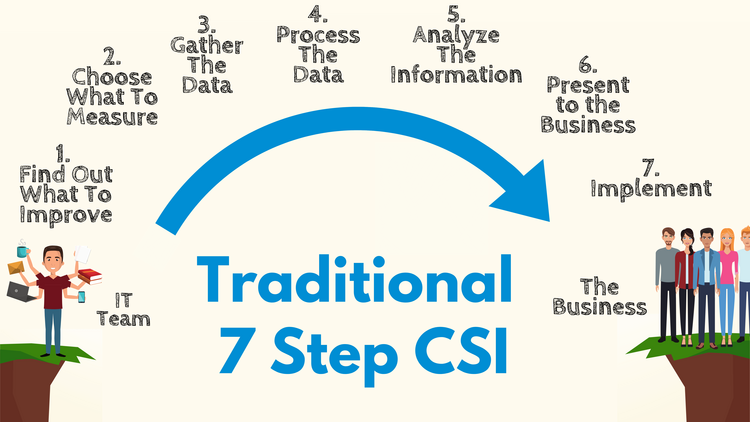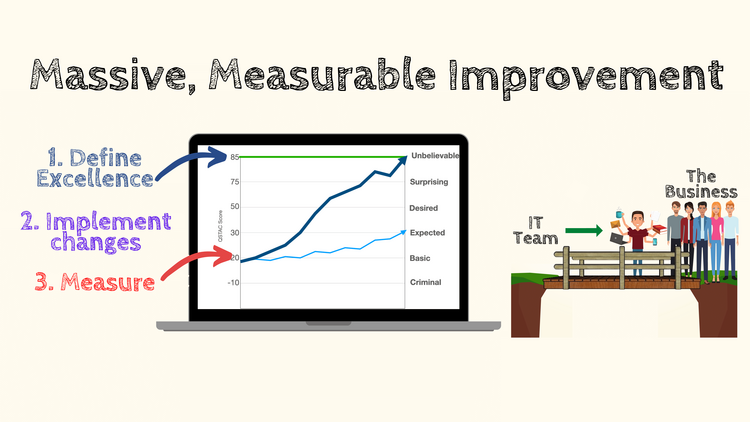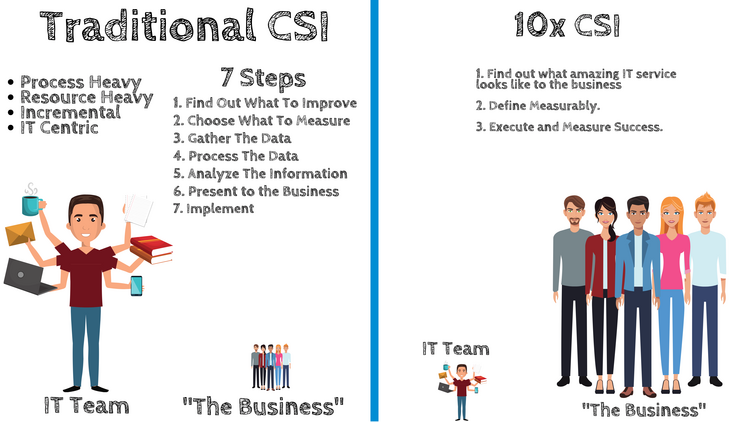Date Published October 2, 2020 - Last Updated October 20, 2020
One of my favorite things about where I work is our company culture. Our team is made up of boisterous, brilliant, fun-loving folks who are obsessed with helping IT teams provide a mind-blowing IT customer experience. As such, there’s a phrase you’re likely to encounter any given day if you work with us: #DoBetter.
In team meetings, you can always count on someone on our team to unmute during a zoom call to proclaim, “C’mon, we can do better!” Not in a mean-spirited way, mind you. The “do better” is typically followed by group laughter and the presenter admitting, “Yeah, we could have probably done better, you’re right.”
This piece of our culture is a product of the 10x continual improvement culture I’ve tried to instill in all of my teams over the years, and a culture I’ve seen in a lot of your teams out there, as well. The 10x philosophy, in essence, means putting processes in place that make your team do its work 10 times better than the average team or the lowest-performing team. With us, it means, why go small in improvement? Go for the moonshot.
The introduction of Continual Service Improvement, or CSI as we’ll refer to it, was meant to help IT teams everywhere #DoBetter by raising the bar of excellence from just meeting Service Level Agreements (SLAs), to continually raising the baseline service level our teams offer to the business.
In theory, CSI was revolutionary in this aspect, and promised to get teams to a world-class service level. In practice, unless led by innovative teams who bend the process to make it work, most CSI initiatives don’t live up to that promise. This is particularly true at companies that measure total cost of ownership (TCO), where businesses are noting that most CSI programs actually cost the business more in process, resources, and time than the net value the business receives.
Don’t worry, this is not bad news. On the contrary, if you’re into service improvement, it’s a huge opportunity to multiply your service improvement and truly #DoBetter for your end users in a way that will really move the needle.

From Incremental to Exponential Improvement
Even if you’ve actually mastered CSI and are seeing great results, that progress is by definition incremental. You go through the seven steps and repeat, improving something each time.
But what if your service improvement was exponential? What if the goal of your CSI program wasn't just to improve your service, but to do so massively and measurably? Our industry recognizes great CSI programs regularly, which is a huge honor, but the real achievement is when the folks you support start singing your praises.
That’s the customer-centric mindset required to multiply the effectiveness of your CSI plan. Here are three hacks that can 10x your CSI initiatives from incremental to exponential. Put even one into practice and your service levels (according to the people you support) will be better than they’ve ever been, guaranteed.
Hack #1: Raise The Bar.
CSI is a “raise the bar” philosophy at its core, meant to help teams define success as more than just hitting SLAs. But how do we raise the bar for excellence even higher than that? What would that even look like? Ron Kaufman has a phenomenal framework to understand your current service level, and what excellence would look like in practice - it is called the “Six Levels of Customer Service”.
Our team uses Ron’s six levels all the time to help teams understand how much better their service could be. The lowest level, aptly called “Criminal Service”, describes the worst customer service you can get, while “Unbelievable Service” is defined as “astonishingly fantastic. This is the level of service the legendary treatment your customers will tell all their friends about.
If you’re familiar with the QSTAC metric, unbelievable service falls at about a QSTAC score of 85. The NPS equivalent would be in the 90s. CSAT unfortunately doesn’t measure that high, but if you have a 100% satisfaction rating, for instance, you’re usually hitting between Level 3 (“Expected”) and Level 4 (“Desired”).
Most IT teams hover between Levels 2 or 3 if you ask their “customers”. But what if your CSI goal was to provide a service level your end users would describe as “Unbelievable Service,” according to Kaufman’s framework? How do you get to that level of excellence that blows away your competition?
Aspire for a 10x goal, like Kaufman’s “Unbelievable Service”, and your service will not only improve 10x as fast, but will reach levels neither your customers or you ever thought possible.
Hack #2: Set a North Star
Great, so you set the bar sky high to “unbelievable service”. Now how the heck do you get there? A goal that ambitious requires a lot of innovation along the way, and the path is different for every service team. The hack? Use what travelers, explorers, and Vikings have used for thousands of years to get to new, far-off places: a north star.
A north star is an unmoving, reliable guide that can point you in the right direction no matter where you are. In our world, this is usually a metric or tool that can define your high bar of excellence numerically, conveniently referred to in many industries as a North Star Metric, or NSM.
A NSM can be used for any team, whether you're a managed service provider, an enterprise IT org, or anything in between. For us, employee end user experience is paramount, so our North Star for excellence is a QSTAC score of 85.
Even if your goal is something other than customer experience, your choice of a North Star Metric is just as vital. Let's say your main objective is cost savings. Choosing the wrong NSM can lead you astray and your CSI initiative could end up actually increasing costs (believe me, this happens a lot!). The more attention you pay to how you measure improvement, the better the results will be. Period.

Hack #3: Go to the Source
When I first heard mention of Continual Service Improvement, I was ready for a next-gen method of driving massive change. When I actually saw the process, I thought someone was pranking me - it is so IT-centric and process heavy, it instantly became clear why experts suggest it fails to live up to its original promise.
One theory for why the traditional 7-step CSI hasn’t lived up to its promise is the amount of assumptions and interpretation applied to the data. If we take the #DoBetter philosophy to heart and look at the 7 steps of CSI with a critical eye, there are some great adjustments you can make that can easily 10x results for your service improvement initiatives. The best part? It’s way simpler to do it this way.
Start with the traditional step number 1 - “Identify the strategy for improvement.” Right out of the gate, ITIL’s guidance is to translate business objectives into IT frameworks. Instead, what if you collected actionable data on what your end users would consider “unbelievable” service? No translation needed. By collecting truly actionable data directly from the source, your end users, you don’t don’t have to wait till step seven to implement. Instead, execution is step number two.
By skipping the steps involved in translating customer needs into an IT framework, processing the data, and then translating that back into customer-centric language, you can now focus all of your energy on execution. If you’ve raised the bar high enough, and have a true NSM to guide you, you can devote all of your resources to addressing end user pain points full force.
Measure it every quarter or so, and if your service level is rising towards that high bar you’ve set, then you’re killing it. Take those dedicated folks who were in charge of gathering, processing, and analyzing the data and put them to work fixing the customer experience. The results are astounding every time.

Whether you’re doing CSI the traditional way, or just trying to “improve where you can”, ask yourself this question: “Is what we’re doing a high enough bar to aspire to, or are we capable of more?” Teams that use the leaner, 10x model for CSI go home every day feeling better about what they do for a living. They are more engaged, and the IT group is more respected and given more autonomy and trust.
Ben Brennan is the founder of QSTAC, Inc. and the author of Badass IT Support. His irreverent style, sincere passion, and contagious enthusiasm for customer-centric IT has proven a powerful combination. The result has been a decade of awards, accolades, and best-in-industry customer experience benchmarks for his IT teams at Twitter, Box, Yahoo, and most recently Verizon Media, where he was Senior IT Director. Now, with his new company QSTAC, Ben is taking the same proprietary tools and methods that fueled those previous successes and making them available to all, empowering any team to define, measure, and deliver a world-class customer experience. Follow him on Twitter @why .